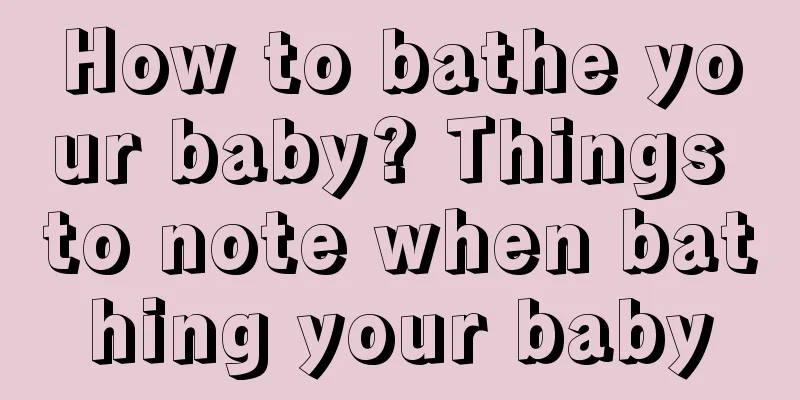How to bathe your baby? Things to note when bathing your baby

|
Babies are relatively young and delicate, so they need our usual care. Bathing is something that everyone has to do. Many new mothers don’t know how to bathe their babies. So how do you bathe your baby? Things to note when bathing your baby. How to bathe your babyThe first step is to take off the clothes and wrap the newborn's body with a large towel. Let the newborn lie on the adult's left thigh. Wash the newborn's hair first. The adult who bathes the newborn should hold the newborn's head and neck with his left hand to protect the ear canal to prevent the bath water from flowing into the ear canal. Then wash the newborn's hair with his right hand. It is best if the shampoo is non-irritating to the eyes to avoid it flowing into the eyes and causing pain, which will make the baby afraid of washing hair or taking a bath in the future. Be sure to rinse with clean water after washing and gently dry the hair with a towel. The second step is to wash the neck and upper body. Wrap the lower body with a large towel first, and use the water in the tub to wash the neck, armpits, chest, back, arms and hands in turn, and dry them after washing. Be careful not to let the bath water flow into the navel when washing the upper body. The third step is to wrap the baby's upper body with a clean large towel and start washing the lower body. At this time, the baby should lie on the adult's left arm with his head close to the adult's left chest. Use your left hand to support the baby's thigh and abdomen, wash the perineum from front to back, and then wash the groin, buttocks, legs and feet. In addition to the above steps, it should be noted that the best time to bathe a newborn is about 1-2 hours before feeding to avoid vomiting. For newborn babies, their umbilical cords have not fallen off yet, so they cannot be bathed in water. Instead, the upper and lower bodies should be washed separately. Baby bathing precautionsInability to take a shower 1. Do not bathe your baby when he/she has a fever, vomiting, or frequent diarrhea, because after bathing, the capillaries of the whole body will dilate, which can easily lead to acute cerebral ischemia and hypoxia, resulting in collapse and shock. How to quickly reduce fever? Please click on this article for babies who are most prone to fever. Moms must save it! 2. Lack of energy, not wanting to eat or even refusing to eat, and sometimes appearing sad and crying, these may be a precursor to the baby's illness or may already be ill. 3. If the fever has subsided after treatment for less than two days and nights, that is, more than 48 hours, it is not suitable to bathe the baby. This is because the baby's resistance is very poor and it is easy to catch a cold and have a fever again. 4. If the baby has burns, scalds, trauma, or impetigo, urticaria, chickenpox, measles, etc., it is not advisable to bathe the baby. Because the baby's body parts have been damaged, inflamed and edematous to varying degrees, bathing immediately will further damage and cause infection. 5. Do not bathe your child on the day of vaccination or in the following days to prevent infection. Parents will often be reminded of this in the vaccination notes. Be sure to strictly follow the doctor's instructions. If it is a hot summer and the child sweats a lot, you can use a wet towel to wipe the child's body, avoiding the injection site. 6. Do not take a bath immediately after feeding, as this will cause more blood to flow to the epidermal blood vessels that dilate after being stimulated by hot water, while the blood supply to the abdominal cavity will be relatively reduced, which will affect the baby's digestive function. Secondly, since the baby's stomach is expanded after feeding, bathing immediately can easily cause vomiting. Therefore, bathing should usually be done 1-2 hours after feeding. Work before taking a shower 1. Time 10am to 3pm is the warmest time of the day, so bathing your baby at this time will prevent him from catching a cold. In addition, it is only necessary to bathe your baby for about 10 minutes at a time. If the baby stays in the water for a long time, it is easy to catch a cold. 2. Water temperature and room temperature It is best for new mothers to use a thermometer to measure the water temperature first. The water temperature suitable for baby bathing is 38~40 degrees. Experienced mothers can use the inside of their wrist to feel it. It is appropriate if it is neither too hot nor too cold. Remember to pour hot water first and then cold water. It is easy to scald the baby if you temporarily add hot water in the middle. Some babies are curious and naughty, so they use their hands to catch the hot water poured by their mothers. Alas, the result is imaginable. We can't let the baby be in such danger. Wash parts separately 1. When the baby is just born to 5 or 6 months old, cradle cap grows on the head, which looks ugly and disgusting. It is best for the mother to gently apply vegetable oil to the baby's scalp, soften it first, and then gently wash it off. Never pick it with your hands. 2. When washing a newborn baby's hair, the mother should use the thumb and middle finger to block the baby's ears to prevent water from entering. The same applies to older babies, which should be waterproof and wipe off the water gently with a cotton swab in time. 3. If the baby's umbilical cord has not fallen off yet, or the belly button is red and swollen, and pus is flowing out, the mother must not let the umbilical cord get wet. Use a cotton swab dipped in hydrogen peroxide solution, or 75% medical alcohol to disinfect it, but do not wipe under the umbilical cord scab. 4. The wrinkles of the baby's skin, the neck, behind the ears, inner thighs, and armpits are all prone to redness, so they need to be washed carefully and gently. Misconception 1: You can wash your clothes anytime, anywhere Children have a high metabolism and the weather is hot, so they often sweat profusely. At this time, many mothers will start bathing without saying anything! But this is really not good! The baby's skin is delicate and the oil is relatively thin. Bathing too frequently will cause damage to the baby's skin! Myth 2: It’s better to keep the water hot to prevent your child from catching a cold Compared with adults' skin, babies' skin is more sensitive. If the water temperature is too hot, it will irritate the baby's skin, causing discomfort and even making the baby afraid of taking a bath! It is recommended that mothers use a thermometer to accurately measure the water temperature when giving their babies a bath. Myth 3: I will just be away for a while and the child will be fine on his own There have been news reports that when the mother was bathing her baby, she went back to the bedroom to answer a phone call, and the baby drowned after returning. Such tragedies must not happen again. In fact, it only takes three to five minutes to bathe a baby. If you persist, it will be fine soon! Myth 4: Don’t tolerate “dirty things” on your baby The baby's nasal mucus, earwax, and belly button are often the areas that mothers focus on cleaning, but few people know that these areas are very fragile and sensitive, and if you are not careful, they will cause infection in the baby. Come and see if you have been poisoned by these four major misunderstandings! I implore mothers to be merciful and let the babies have a pleasant bath! In addition, we also need to remind everyone that after bathing the baby, you must first use a bath towel to dry the hair before leaving the bathroom! To prevent the alternation of cold and hot from inducing a cold in the baby! Things to note when bathing your baby in summerMany confinement nannies have this worry: when giving a baby a bath, the baby is extremely uncooperative and screams. In fact, giving a baby a bath is a simple thing, but there are many taboos, and confinement nannies also need to handle it with caution. Today, just follow the steps I will teach you, it is super useful. 01. Let’s first talk about the following situations in which babies cannot take a bath: 1. Do not bathe your baby when he has fever, vomiting, or frequent diarrhea, because the capillaries throughout the body will dilate after a bath, which can easily lead to acute cerebral ischemia, hypoxia, and collapse and shock. 2. If the baby is listless, does not want to eat or even refuses to eat, and sometimes appears sad and cries, this may be a sign that the baby is sick or is already sick. In this case, bathing the baby will inevitably cause the child to have a fever or aggravate the development of the disease. 3. If the fever has subsided after treatment for less than two days and nights, that is, more than 48 hours, it is not suitable to bathe the baby. This is because the baby with fever has very poor resistance and it is easy to get a fever again due to external cold. 4. If the baby has burns, scalds, trauma, or impetigo, urticaria, chickenpox, measles, etc., it is not suitable to bathe the baby. This is because the baby's body parts have been damaged, inflamed and edematous to varying degrees, and bathing immediately will further damage and cause infection. 5. Do not bathe your child on the day of vaccination or in the following days to prevent infection. Parents will often be reminded of this in the vaccination instructions. Be sure to follow the doctor's instructions strictly. If it is a hot summer and the child sweats a lot, you can wipe the child's body with a wet towel, avoiding the injection site. 6. Do not take a bath immediately after feeding, as this will cause more blood to flow to the epidermal blood vessels that are dilated by the hot water, while the blood supply to the abdominal cavity will be relatively reduced, which will affect the baby's digestive function. Secondly, since the baby's stomach is dilated after feeding, taking a bath immediately may easily cause vomiting. Therefore, it is usually best to take a bath 1-2 hours after feeding. 02. Next, let’s talk about how to deal with babies crying while taking a bath Water games: In fact, every baby is born to love playing with water. You can put more toys in the bathtub, such as plastic boats, funnels, cups, inflatable ducks, etc., to add fun to the baby's bath. At the same time, bathing is also an important opportunity to communicate with the baby and play educational games. for example: Put some items in the water and let your baby observe carefully which ones sink and which ones float; Put a water toy in the water and let your baby play freely; See if he can use a wooden spoon to scoop up some toys floating in the water; Try filling or emptying containers such as plastic spoons, yogurt pots, plastic cups, bowls, and bottles; Fill a sponge with water and squeeze the water into a container to show your baby how water is stored; Listen to different sounds, such as dripping, boiling, splashing, etc., and then name the sounds; Give your doll or toy person a bath, wash its hair, and talk about different parts of the body. Then dry it off and put it to bed. Note: For newborn babies, it is recommended that each bath time be controlled within 5 to 10 minutes. Do not bathe too long to avoid catching a cold. 03. The following are the steps to give your baby a bath. They are very useful. When you start bathing, you need to do these things well. 1. Time 10am to 3pm is the warmest time of the day, so bathing your baby at this time will prevent him from catching a cold. In addition, it is only necessary to bathe your baby for about 10 minutes at a time. If the baby stays in the water for a long time, it is easy to catch a cold. 2. Water temperature and room temperature It is best for new mothers to use a thermometer to measure the water temperature first. The water temperature suitable for baby bathing is 38~40 degrees. Experienced mothers can use the inside of their wrist to feel it. It is appropriate if it is neither too hot nor too cold. Remember to pour hot water first and then cold water. It is easy to scald the baby if you temporarily add hot water in the middle. Some babies are curious and naughty, so they use their hands to catch the hot water poured by their mothers. Alas, the result is imaginable. We can't let the baby be in such danger. Note: Avoid convection wind Action 1: Close the windows In summer, the temperature is high and the room temperature does not need to be adjusted, but the windows should still be closed when the baby is bathing to prevent wind from blowing in. Wait until the baby has finished bathing and is dressed before opening the window, otherwise the baby will easily catch a cold after the damp skin is blown by the wind. Measure 2: Get dressed before leaving After a mother has just given her baby a bath, she is often covered in sweat and will feel that the baby is also very hot. She will easily carry the baby to a fan or an air-conditioned room immediately after the bath. In this way, the baby's skin capillaries and sweat glands will shrink, reducing resistance, which can easily cause the baby to catch a cold. After closing the doors and windows, the mother should keep the room temperature at 24-28℃ to prevent the baby from being blown by the wind. Wash parts separately ① When the baby is just born to 5 or 6 months old, cradle cap grows on the head, which looks ugly and disgusting. It is best for the mother to gently apply vegetable oil to the baby's scalp, soften it first, and then gently wash it off. Never pick it with your hands. ② When washing a newborn baby's hair, the mother should use the thumb and middle finger to block the baby's ears to prevent water from entering. The same applies to older babies, which should be waterproof and wipe off the water gently with a cotton swab in time. ③If the baby's umbilical cord has not fallen off yet, or the belly button is red and swollen, and pus is flowing out, the mother must not let the umbilical cord get wet. Use a cotton swab dipped in hydrogen peroxide solution, or 75% medical alcohol to disinfect it, but do not wipe under the umbilical cord scab. ④ The baby's skin wrinkles, neck, behind the ears, inner thighs, and armpits are all prone to redness, so they need to be washed carefully and gently. When taking a bath, it is very helpful to follow these steps: 1: Take off the baby's clothes, remove the diaper, expose the whole body, and wrap the baby in a bath towel. Hold the baby gently with your left arm and body, support the baby's head with your left hand, and use your left thumb and middle finger to press the auricle from behind the ear to make it fold back to cover both ear holes to prevent bath water from flowing into the ear. 2: Wash the face first. Wet a small towel for washing the face, and use its two small corners to clean the baby's eyes, gently wiping from the inside of the eye to the outside; use one side of the small towel to clean the nose, mouth, and face; use the other two corners of the small towel to clean the two ears, auricles, and behind the ears. Wash your head with a little shampoo, massage your scalp, rinse with clean water, and then dry with a small towel. 3: After washing the head and face, remove the bath towel, hold the baby's left arm with your left hand, and let the baby rest his head on the left arm; wet the baby's upper body with clean water, dip a small face towel in your right hand into a little shower gel, let the baby's head tilt back slightly, and then wash the neck, chest, armpits, abdomen, upper and lower arms, and palms. Pay attention to the cleaning of the skin wrinkles, and then rinse off the foam with clean water. 4: Use a small towel for washing buttocks to dip a little bath gel to clean the baby's groin and perineum. Change your right hand to hold the baby's left arm, let the baby lie on the right arm, and wash the back, buttocks, lower limbs, and feet. 5: After rinsing the baby's whole body with clean water again, take the baby out of the bathtub, dry the whole body with a large bath towel, place the baby on the bed or table covered with clean sheets, cover the baby with a small quilt, and prepare for post-bath care. The entire bathing time is 5 to 10 minutes. The bathing time should not be too long to prevent the water temperature from dropping and causing the baby to catch a cold. After-wash care is equally important ① When dressing your baby or using diapers, be slow and gentle, and don't rush. ② Remember to wipe your baby’s body with lotion, diaper cream and massage oil. Combining the massage movements will also improve your baby’s IQ, killing two birds with one stone. ③Now in summer, many mothers will use prickly heat powder and talcum powder after washing their babies, but they also have safety risks. It is best to use plant-based ones, which are safe and natural. Bathing a baby may seem simple, but it is actually a very particular matter. However, as long as you do a good job of preparation and pay attention to the details when bathing your baby, bathing your baby will become easy and fun! 1. How often should you take a bath? Babies have delicate skin. Frequent bathing will destroy the sebum on their skin and cause dry skin. If you bathe too little, a lot of dirt will accumulate on the baby's body, which will also make it itchy and uncomfortable. The "Chinese Skin Cleansing Guide" recommends that babies under 1 year old should be bathed twice a week before they can crawl, and at most once every other day. When the weather gets hot or the baby's activity level increases, the bathing frequency can be appropriately increased. It is recommended that you respond flexibly based on the temperature and humidity in your city, whether the air conditioner is often turned on at home, whether bathing is convenient, as well as your baby's health condition, how much sweating occurs, and how accepting bathing is. 2. How to bathe your baby? Babies of different ages use different bathing methods, the most common ones are sponge bath and tub bath. ※Baby sponge bath: 1 to 2 weeks after birth, before the umbilical cord stump falls off, it is recommended to only give the baby a sponge bath. Wrap the baby in a bath towel, exposing only the parts that need to be cleaned each time. 1. Wash the face: First, use a wet towel to clean the baby's face. No shower gel is needed to avoid the foam getting into the baby's eyes and mouth. 2. Washing hair: Use your fingertips to gently massage the baby's scalp, including the fontanelle. If the baby has hair, you can use baby products, but it is not recommended to use them frequently to avoid disrupting the balance of scalp sebum. Using it 1-2 times a week is enough. 3. Scrub the body: Use a towel to soak in warm water with shower gel and wipe the rest of the baby's body. Scrub from top to bottom, and finally clean the baby's butt. When swabbing, pay special attention to cleaning the neck, behind the ears, underarms, elbows, groin, and leg folds. 4. Scrub with clean water: Use clean water to completely scrub off any residual bath products on the baby's body and hair. 5. Apply moisturizer: After bathing, dry your baby and immediately apply fragrance-free, hypoallergenic baby lotion to prevent skin from drying out. Bathing your baby in a tub: Once your baby's umbilical cord stump has fallen off and healed, you can try bathing him directly in the tub. 1. First bath: The baby's first bath should be as gentle and brief as possible. Some babies may show some resistance. If they seem uncomfortable, you can continue to extend the sponge bath for 1-2 weeks and then try the bath. The baby will adapt better. 2. Items you need to prepare before taking a tub bath: The supplies for a tub bath are similar to those for a sponge bath. You can prepare an extra clean cup to help your baby rinse. 3. Fill the bathtub with water: Fill the bathtub with suitable warm water (35℃~37℃), and keep the baby's face and most of the body above the water to ensure his safety. 4. Put the baby in the basin: After taking off all the clothes, you should put him in warm water in time to prevent him from getting cold. Support the baby's head with one hand and put him in the water with the other hand. Put his feet in first, and while saying some encouraging words to him, gently put the rest of his body into the water. 5. Cleaning order: Like the sponge bath, the tub bath is also taken from top to bottom, first wash the face, then wash the hair, and finally clean other parts of the body. 6. Keep warm at all times: Adults need to constantly rinse their exposed parts of the body with warm water. 7. Leave time for your baby to play with water: If your baby likes taking a bath, you can give him more time to play with water. The more your baby likes taking a bath, the less afraid he will be of water. Taking a bath is a very relaxing experience for your baby. Unless your baby is very resistant, don't rush to end it. But be sure to keep the water temperature constant. 8. Apply moisturizer: Dry your baby after bathing and apply baby lotion. 3. Several time periods to avoid when taking a bath: 1. Don't bathe your baby when he is hungry: When your baby is hungry, the body will instinctively protect itself, and the amount of blood circulating on the surface of the body will be less than usual. If you bathe your baby at this time, the brain may be ischemic and hypoxic, resulting in dizziness or even fainting. 2. Do not bathe within half an hour after a meal: When you have just finished a meal, the body's blood circulation is concentrated in the digestive system. If you bathe at this time, the digestive system cannot work well, and symptoms such as bloating and vomiting may occur. So it is best to wait half an hour after the baby has finished a meal, play with the baby for a while, and then bathe the baby. 3. Do not bathe when the skin is severely damaged: It is not recommended to bathe the baby when there is a wound or severe damage on the skin, so as to avoid contaminating the wound and affecting healing. If the wound is not big and is protected by a waterproof patch, you can bathe, but be careful to avoid the wound. Bathing steps1. Take off the baby's clothes, remove the diaper, expose the baby's whole body, and wrap him in a bath towel. The adult gently holds the baby with his left arm and body, supports the baby's head with his left hand, and presses the auricle from behind the ear with his left thumb and middle finger to fold it back to cover both ear holes and prevent bath water from flowing into the ear. 2. Wash the face first. Wet a small towel for washing the face, and use its two small corners to clean the baby's eyes, gently wiping from the inside of the eye corners to the outside; use one side of the small towel to clean the nose, mouth, and face; use the other two corners of the small towel to clean the two ears, auricles, and behind the ears. Use a little shampoo to wash the head, massage the scalp, rinse with clean water, and then dry with a small towel. 3. After washing the head and face, remove the bath towel, hold the baby's left arm with your left hand, let the baby's head rest on the left arm; wet the baby's upper body with clean water, dip a small face towel in your right hand into a little shower gel, let the baby's head tilt back slightly, and then wash the neck, chest, armpits, abdomen, upper and lower arms, and palms. Pay attention to the cleaning of skin wrinkles, and then rinse off the foam with clean water. 4. Use a small towel for washing buttocks to dip a little bath gel to clean the baby's groin and perineum. Change your right hand to hold the baby's left arm, let the baby lie on the right arm, and wash the back, buttocks, lower limbs, and feet. 5. After rinsing the baby's whole body with clean water again, take the baby out of the bathtub, dry the whole body with a large bath towel, place the baby on the bed or table covered with clean sheets, cover the baby with a small quilt, and prepare for post-bath care. The entire bathing time is 5 to 10 minutes. The bathing time should not be too long to prevent the water temperature from dropping and causing the baby to catch a cold. |
<<: What kind of people are not suitable for natural childbirth? What factors affect it?
>>: Are pregnant women with twins more likely to have premature births?
Recommend
What are the benefits of eating sunflower oil for children to grow taller?
The healthy growth of children is the most import...
What is the cause of cerebral hypoxia in newborns and how to care for them
Newborns may have more or less problems due to th...
How to improve your baby's picky eating How to deal with your baby's picky eating
When babies eat, they will inevitably show sympto...
Why are babies particularly sensitive? Four characteristics of highly sensitive children
The issue of skin sensitivity has always been a f...
Will eating bird's nest make you fat after giving birth? How long is the best time to eat bird's nest after giving birth?
Postpartum obesity is the most feared thing for e...
Can toothpaste for pregnant women relieve morning sickness? Precautions for pregnant women to choose toothpaste
Everyone should have heard of toothpaste for preg...
Is it okay not to shave the baby's hair? When does the newborn's hair fall off?
Many parents will shave their baby's hair as ...
Are antipyretics harmful to the kidneys? Side effects of antipyretics on children
Baby fever is a common problem. Today, let's ...
How are Pampers diapers? Which series of Pampers diapers is the best?
Pampers diapers are also the first choice of moth...
Is Feihe milk powder goat milk powder or cow milk powder? Is Feihe milk powder hydrolyzed milk powder?
Feihe milk powder is a very common milk powder br...
Is the laundry detergent a neutral detergent? Is the more foam the better?
Laundry detergent is a very important cleaning pr...
Do women age faster after giving birth? What should I do if I age faster after giving birth?
After giving birth, women seem to age faster. The...
Will the baby be hungry if he doesn't want to drink milk? What should I do if the baby resists milk powder?
There are many reasons why babies don't want ...
How is the breathability of Kao diapers? Is Kao diapers suitable for boys or girls?
When choosing diapers for babies, breathability i...
What should I do if my baby often causes trouble at home?
Babies are naturally active and always make troub...









